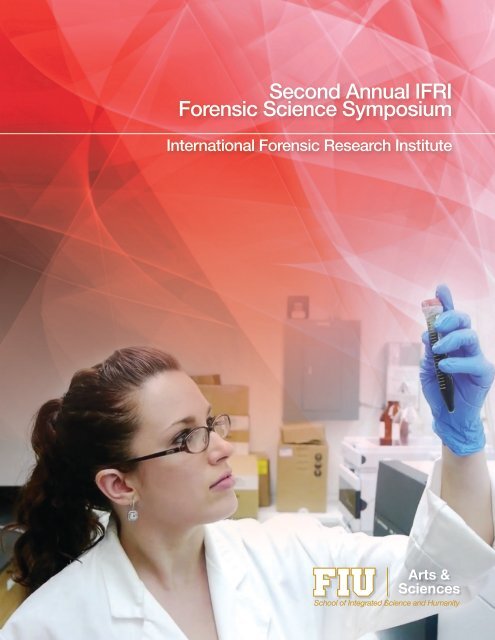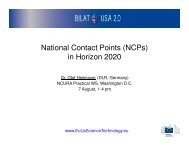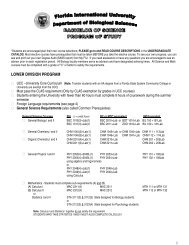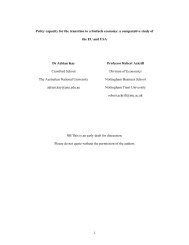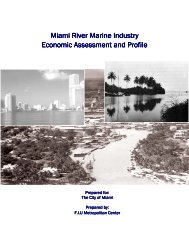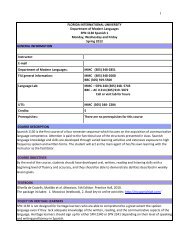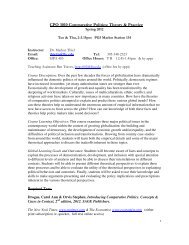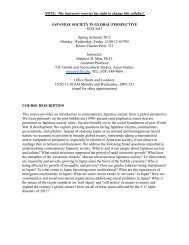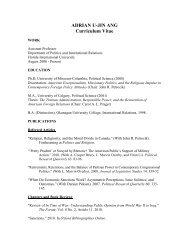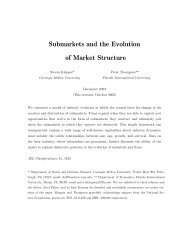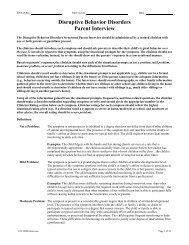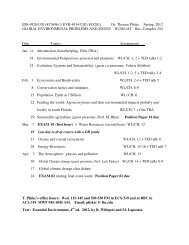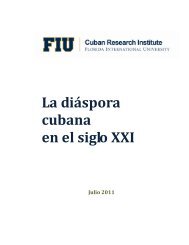Second Annual IFRI Forensic Science Symposium - College of Arts ...
Second Annual IFRI Forensic Science Symposium - College of Arts ...
Second Annual IFRI Forensic Science Symposium - College of Arts ...
Create successful ePaper yourself
Turn your PDF publications into a flip-book with our unique Google optimized e-Paper software.
<strong>Second</strong> <strong>Annual</strong> <strong>IFRI</strong><br />
<strong>Forensic</strong> <strong>Science</strong> <strong>Symposium</strong><br />
International <strong>Forensic</strong> Research Institute<br />
March 13 - 14, 2013<br />
School <strong>of</strong> Integrated <strong>Science</strong> and Humanity
School <strong>of</strong> Integrated <strong>Science</strong> and Humanity<br />
<strong>Symposium</strong> Advisory Board<br />
Stephanie Stoil<strong>of</strong>f<br />
James Ongley<br />
Tatiana Trejos<br />
Bruce McCord<br />
Howard Holness
It is with great pleasure that we welcome you to FIU for the <strong>Second</strong> <strong>Annual</strong> <strong>IFRI</strong> <strong>Forensic</strong> <strong>Science</strong> <strong>Symposium</strong>.<br />
This meeting is a continuation <strong>of</strong> a series <strong>of</strong> ad-hoc forensic science meetings previously held in South Florida<br />
(Nova Southeastern University, Miami-Dade Police, Broward Sheriff, etc.). This year, the <strong>IFRI</strong> advisory board<br />
decided to expand on the very successful symposium held in March 2012 by again bringing together the<br />
talented practicing scientists and researchers in the South Florida area to showcase advances in the rapidly<br />
evolving fields within the forensic sciences. The more than 200 practicing scientists and more than 100<br />
faculty and students at FIU and other institutions combine to provide a forum for information exchange that<br />
is mutually beneficial to both the researchers and the practicing scientists. The aims <strong>of</strong> this symposium are<br />
to provide continuing education opportunities for forensic scientists with presentations <strong>of</strong> recent research<br />
findings and new technologies, to provide the faculty and students a mechanism to showcase their research<br />
and together coordinate responses to challenges in forensic casework. The symposium will be <strong>of</strong>fered over<br />
two days with five workshops, a keynote presentation, 25 oral presentations and 28 poster presentations.<br />
This symposium would not have been possible without the generous support <strong>of</strong> our collaborators: Miami-<br />
Dade Police Department, Broward Sheriff’s Office, Palm Beach County Sheriff’s Office, and their leadership<br />
as well as the corporate sponsors: Agilent, Life Technologies, Bruker, LGC <strong>Forensic</strong>s, Qiagen, IonSense and<br />
Eppendorf. We are also grateful to the other forensic laboratories throughout Florida for their participation and<br />
to the faculty and staff at FIU’s International <strong>Forensic</strong> Research Institute for assistance with the coordination<br />
<strong>of</strong> this event.<br />
Sincerely,<br />
<strong>Second</strong> <strong>Annual</strong> <strong>IFRI</strong><br />
<strong>Forensic</strong> <strong>Science</strong> <strong>Symposium</strong><br />
International <strong>Forensic</strong> Research Institute<br />
José R. Almirall<br />
Director, International <strong>Forensic</strong> Research Institute<br />
Co-Chair, <strong>Second</strong> <strong>Annual</strong> <strong>IFRI</strong> <strong>Forensic</strong> <strong>Science</strong> <strong>Symposium</strong><br />
Cecelia A. Crouse<br />
Crime Laboratory Director, Palm Beach County Sheriff’s Office<br />
Co-Chair, <strong>Second</strong> <strong>Annual</strong> <strong>IFRI</strong> <strong>Forensic</strong> <strong>Science</strong> <strong>Symposium</strong><br />
March 13 - 14, 2013<br />
Hosted by Florida International University | 3
<strong>Second</strong> <strong>Annual</strong> <strong>IFRI</strong> <strong>Forensic</strong> <strong>Science</strong> <strong>Symposium</strong> • March 13 - 14, 2013<br />
Wednesday, March 13<br />
4 | Hosted by Florida International University<br />
Program<br />
Applications <strong>of</strong> the <strong>Science</strong>s in the <strong>Forensic</strong> <strong>Science</strong>s (SIPA 125)<br />
Stephanie Stoil<strong>of</strong>f<br />
1:00 – 2:00 p.m. Registration<br />
2:00 – 2:10 p.m. Welcome and opening remarks<br />
2:10 – 2:40 p.m. Tool mark examinations in the Lindbergh kidnapping case, John M. Mancini<br />
2:40 – 3:00 p.m. Go with the flow: Palm Beach County Sheriff’s Office early user evaluation <strong>of</strong> the RapidHITTM 200,<br />
Karin Crenshaw<br />
3:00 – 3:30 p.m. Research study for the reliability <strong>of</strong> the ACE-V process; accuracy, precision, reproducibility and repeatability in<br />
latent fingerprint examinations, Igor Pacheco and Brian Cerchiai (Miami-Dade Police Department)<br />
3:30 – 4:00 p.m. Application <strong>of</strong> LA-ICP-MS for the elemental pr<strong>of</strong>iling <strong>of</strong> glass, ink, paper and chemical taggants,<br />
Tatiana Trejos and José R. Almirall<br />
4:00 – 5:00 p.m. Keynote speaker: Kevin C. McElfresh – Advanced genome technology and forensics, looking forward through<br />
the lens <strong>of</strong> 25 years <strong>of</strong> casework<br />
5:00 – 5:15 p.m. Special tribute to Bud Stuver, former supervisor <strong>of</strong> Miami-Dade Police Department biology section<br />
5:15 – 7:00 P.M. RECEPTION AND POSTER SESSION<br />
Thursday, March 14<br />
Session 1 – Breakout: Veterinary <strong>Forensic</strong> <strong>Science</strong> and Firearms (SIPA 103)<br />
Chairperson: Jessica Brown<br />
8:30 – 9:00 a.m. Veterinary forensic sciences, J. H. Byrd<br />
9:00 – 9:25 a.m. Animal cruelty crime scenes: The role <strong>of</strong> the forensic veterinarian, Rachel Touroo<br />
9:25 – 9:45 a.m. Application <strong>of</strong> forensic principles to the protection <strong>of</strong> fish and wildlife resources and other cases involving<br />
examination <strong>of</strong> animal-related evidence, Hector Cruz-Lopez and Kristen Hoss<br />
9:45 – 10:10 a.m. Illegal slaughter <strong>of</strong> horses in Miami-Dade and Broward counties, DeEtta Mills<br />
10:10 – 10:30 A.M. BREAK<br />
10:30 – 11:05 a.m. Possible sources for false positives when conducting the Modified Griess Test for the detection <strong>of</strong> gunshot<br />
residues, Phase IV., Jorge Bello and Christopher Barr<br />
11:05 – 11:30 a.m. An empirical study to improve the scientific foundation <strong>of</strong> forensic firearm and tool mark identification utilizing<br />
consecutively manufactured Glock EBIS barrels with the same EBIS pattern, Gabriel A. Hernandez<br />
11:30 – 12:00 p.m. Evidentiary value continued research <strong>of</strong> swabbing the front sight on handguns for DNA analysis,<br />
Sara Cole, Earl Gordon, Victor Morillo and Cara Lopez<br />
12:00 – 1:00 P.M. LUNCH<br />
Session 2 – Breakout: Drug Analysis/Toxicology (SIPA 100)<br />
Chairperson: Luis E. Arroyo-Mora<br />
8:30 – 8:55 a.m. A study <strong>of</strong> blood alcohol stability in forensic antemortem blood samples, Dustin Tate Yeatman, Xiaoqin Shan,<br />
Nicholas B. Tiscione and Ilene Alford<br />
8:55 – 9:20 a.m. Quantitation <strong>of</strong> Ethanol and identification <strong>of</strong> other volatiles by headspace gas chromatography with<br />
simultaneous flame ionization and mass spectrometric detection, Nicholas B. Tiscione, Ilene Alford,<br />
Dustin Tate Yeatman, Xiaoqin Shan (Palm Beach County Sheriff’s Office) Joe Kahl (Miami-Dade Medical<br />
Examiner Department)
<strong>Second</strong> <strong>Annual</strong> <strong>IFRI</strong> <strong>Forensic</strong> <strong>Science</strong> <strong>Symposium</strong> • March 13 - 14, 2013<br />
9:20 – 9:45 a.m. Fast detection <strong>of</strong> peroxide explosives using Planar Solid Phase Microextraction (PSPME) coupled to Ion<br />
Mobility Spectrometers (IMS), Wen Fan, Mimy Young and José R. Almirall<br />
9:45 – 10:10 a.m. Submerged remains: a study on the scent <strong>of</strong> death, Iris Caraballo and Kenneth G. Furton<br />
10:10 – 10:30 A.M. BREAK<br />
10:30 – 11:00 a.m. Rapid screening <strong>of</strong> 725 drugs and metabolites in 7.5 minutes with GC/MS TOX analyzer,<br />
Fred Feyerherm (Agilent Technologies)<br />
11:00 – 11:30 a.m. Cross-reactivity <strong>of</strong> cathinone derivatives and other designer drugs in commercial immunoassays,<br />
Madeleine J. Swortwood and Anthony P. DeCaprio<br />
11:30 – 12:00 p.m. Broad-based screening <strong>of</strong> bath salts, synthetic cannabinoids, and other designer drugs by LC-QQQ-MS<br />
and LC-QTOF-MS, Anthony P. DeCaprio, Ana-Michelle Broomes, Joshua Z. Seither,<br />
Madeleine J. Swortwood, and Luis E. Arroyo-Mora<br />
12:00 – 1:00 P.M. LUNCH<br />
Session 3 – Breakout: DNA Analysis and <strong>Forensic</strong> Laboratory Management (SIPA 125)<br />
Chairperson: Cecelia Crouse<br />
8:30 – 8:55 a.m. ParaDNA ® : The technology, Randy Nagy, Mark Dearden, Paul Rendell, Simon Wells, Stephen Blackman<br />
8:55 – 9:20 a.m. Obtaining genotype out <strong>of</strong> low-copy number DNA, Pero Dimsoski, Julian Mendel, Bruce McCord<br />
and DeEtta Mills<br />
9:20 – 9:45 a.m. DNA methylation markers as a powerful technique to discriminate body fluids present in crime scenes,<br />
Joana Antunes, Tania Madi, Kuppareddi Balamurugan, Robin Bombardi, George Duncan and<br />
Bruce McCord<br />
9:45 – 10:10 a.m. Cutting out the middle (wo)man: implementing a direct outsourcing strategy for DNA cases,<br />
Celynda Sowards<br />
10:10 – 10:30 A.M. BREAK<br />
10:30 – 11:00 a.m. Divide and conquer: a novel approach to tackling a growing DNA backlog and increasing turnaround times,<br />
Angela Spessard<br />
11:00 – 11:30 a.m. The ABC’s <strong>of</strong> forensic certification, Angie Vassalotti<br />
11:30 – 12:00 p.m. Spatial autocorrelation <strong>of</strong> soil biota pr<strong>of</strong>iles with soil type can be used for soil provenance, Natalie Damaso,<br />
Maria Mendoza and DeEtta Mills<br />
12:00 – 1:00 P.M. LUNCH<br />
Workshops<br />
1:00 – 3:00 p.m. SIPA 100 – Big & small; inside & out; long & short sample analyses for forensic sciences using vibrational<br />
spectroscopy techniques by Agilent Technologies<br />
SIPA 103 – 6-dye evolution: prepare your lab for the future <strong>of</strong> CE fragment analysis by Life Technologies<br />
3:00 – 5:00 p.m. OE 107 – Designer drug screening using DART and GC-QQQ by Florida International University, Agilent<br />
Technologies (GC-MS) and IonSense (DART-MS)<br />
SIPA 100 – ParaDNA ® workshop by LGC <strong>Forensic</strong>s<br />
SIPA 103 – Improving differential workflow efficiency workshop by Qiagen<br />
Hosted by Florida International University | 5
<strong>Second</strong> <strong>Annual</strong> <strong>IFRI</strong> <strong>Forensic</strong> <strong>Science</strong> <strong>Symposium</strong> • March 13 - 14, 2013<br />
6 | Hosted by Florida International University<br />
Poster Abstracts<br />
1. Comparative detection <strong>of</strong> biowarfare agent surrogate DNA signature sequences via qPCR in defined backgrounds and clinical samples<br />
Jonathan Segal, Florida International University<br />
Real-time quantitative polymerase chain reaction (real-time qPCR) assays are a popular and effective option to detect biowarfare agents. Although realtime<br />
assays exist to detect both B. anthracis and Y. pestis, such assays are rarely validated in relevant clinical samples. In this study, SYBR-green realtime<br />
qPCR assays have been designed using chromosomal signature sequences to specifically detect biowarfare agent surrogates B. thuringiensis and<br />
S. marcescens. Currently, the efficiencies <strong>of</strong> both assays are being tested in a variety <strong>of</strong> conditions: pure-culture bioagent DNA, bioagent DNA spiked into<br />
constructed DNA mixtures (closely related and common lung species), and bioagent DNA spiked into DNA extracted from five clinical bronchoalveolar<br />
lavage (BAL) lung samples <strong>of</strong> unknown composition. Comparison <strong>of</strong> PCR amplification pr<strong>of</strong>iles and other assay parameters between conditions could<br />
provide some insight to the importance <strong>of</strong> background composition on single species detection, particularly at low DNA concentrations. This study is<br />
particularly poignant because <strong>of</strong> the inclusion <strong>of</strong> clinical samples from the lung, the main organ-<strong>of</strong>-entry <strong>of</strong> both B. anthracis and Y. pestis.<br />
2. Evaluation and Comparison <strong>of</strong> Planar Solid Phase Microextraction (PSPME) with Other Substrates for Headspace Sampling <strong>of</strong> Cocaine and<br />
MDMA Coupled to Ion Mobility Spectrometry<br />
Mimy Young, Wen Fan and José R. Almirall, International <strong>Forensic</strong> Research Institute<br />
A novel planar solid phase microextraction (PSPME) sorbent-coated disk has been developed for the sampling and preconcentration <strong>of</strong> volatile chemical<br />
markers typically detected in illicit drugs and coupled to ion mobility spectrometry systems. The novel extraction phase <strong>of</strong>fers a 10,000X increase in<br />
surface area and significantly increased phase volume capacity for fast sampling and preconcentration <strong>of</strong> analytes in comparison to fiber-based solid<br />
phase microextraction (SPME). While PSPME-IMS has been previously coupled to ion mobility spectrometry (IMS) for the identification <strong>of</strong> volatile<br />
chemical compounds found in illicit drugs (methyl benzoate for cocaine and piperonal for MDMA), we report for the first time, the extraction and retention<br />
capabilities <strong>of</strong> PSPME in comparison to other sampling substrates such as the commercially used Teflon coated swabs and uncoated glass filters. Static<br />
extractions using PSPME resulted in significant improvements in the extraction efficiency as well as retention capability for the volatile compounds<br />
associated with Cocaine and MDMA from static and dynamic extractions.<br />
3. New Mite Species Described in Human Death Investigation: Implications for <strong>Forensic</strong> Entomology and Decomposition Ecology<br />
Charity G. Owings, Meaghan L. Pimsler, Barry M. O‘Connor, Aaron M. Tarone, Jeffery K. Tomberlin, University <strong>of</strong> Florida<br />
The partially mummified remains <strong>of</strong> an elderly gentleman were discovered in his bed in April 2011 during a routine wellness check. Immature flies <strong>of</strong><br />
the species Synthesiomyia nudiseta Wulp (Diptera: Muscidae) had pupated in a large mass <strong>of</strong> tangled hair <strong>of</strong> the decedent, instead <strong>of</strong> dispersing from<br />
the remains and forming cocoons <strong>of</strong> saliva and detritus. During processing for forensic entomological analysis, a previously unnoticed mite population<br />
was discovered. These mites constitute a new species within the genus Myianoetus (Asitgmata: Histiostomatidae), and represent the first recorded mite<br />
associated with this species <strong>of</strong> cosmopolitan fly. A description <strong>of</strong> the Myianoetus species as well as a discussion <strong>of</strong> the reciprocal implications in forensic<br />
entomology, acarology, and decomposition ecology will be presented.<br />
4. Comparison <strong>of</strong> Scanning Electron Microscope and 3D Digital Imaging Microscope for <strong>Forensic</strong> Applications<br />
Melissa Zwilling, José R. Almirall, International <strong>Forensic</strong> Research Institute<br />
The ability to analyze trace evidence is essential in forensic examinations. The physical characteristics <strong>of</strong> small fragments <strong>of</strong> evidence are <strong>of</strong>ten determined via scanning<br />
electron microscopy (SEM), which can have magnification from 50x-50,000x. SEMs have been used to examine line crossings on paper documents, paper fibers, paint and<br />
coatings, gunshot residue, and laser ablation craters in glass, amongst others. While effective, this technique does have some drawbacks. All samples must be maintained in<br />
a vacuum, and technical expertise is required for operation. In addition, determination <strong>of</strong> three-dimensional features such as volume and morphology is a tedious process on<br />
SEM, sometimes requiring hours for analysis <strong>of</strong> a single sample. Recent progress in digital microscopy has improved resolution such that forensic evidence can be examined<br />
with detail comparable to that <strong>of</strong> SEM, but without the need for a vacuum using light microscopy instead <strong>of</strong> an electron beam raster. In addition, the digital optical method is<br />
such that 3D features <strong>of</strong> common forensic samples can be determined, such as depth <strong>of</strong> bullet striations. Additional benefits include the short time required to operate the<br />
instrument, which is a matter <strong>of</strong> seconds to minutes, and operation <strong>of</strong> the instrument requires minimal training and maintenance. Here, the three-dimensional morphologies<br />
<strong>of</strong> several samples <strong>of</strong> forensic interest are examined, such as bullet striations, tool marks, and fibers, showing the benefit <strong>of</strong> 3D resolution with the advantages <strong>of</strong> ease, cost<br />
and speed.<br />
5. Separation and Identification <strong>of</strong> Synthetic Cathinones using GC/MS, GC/MS/MS and ESI-IMS-MS<br />
Seongshin Gwak, Luis E. Arroyo-Mora and José R. Almirall, International <strong>Forensic</strong> Research Institute<br />
Cathinone is the main component <strong>of</strong> the khat plant which produces a stimulating effect similar to amphetamines. In this study, 6 synthetic cathinones,<br />
recently scheduled as Schedule I controlled substances in Florida as <strong>of</strong> July 2012, 4-methylmethcathinone (4-MMC), 3-fluoromethcathinone (3-FMC),<br />
4-methylethcathinone (4-MEC), 4-methoxymethcathinone (methedrone), 3,4-methylenedioxymethcathinon (methylone) and 3,4-methylenedioxypyrovalerone<br />
(MDPV), were analyzed using a commercially available electrospray ionization-ion mobility spectrometer-mass spectrometer (ESI-IMS-MS), a gas<br />
chromatograph-mass spectrometer (GC/MS) using electron ionization (EI) and a GC/MS/MS Triple Quadrupole (QQQ) with both EI and chemical ionization<br />
(CI) modes. One <strong>of</strong> the advantages <strong>of</strong> using the s<strong>of</strong>ter CI and ESI ionization sources is the creation <strong>of</strong> molecular ions <strong>of</strong> the easily fragmented compounds<br />
and, in the case <strong>of</strong> ESI, the ability to analyze nonvolatile compounds and ionize compounds in the liquid phase. We report a fast and selective method<br />
that can be used to unambiguously identify this important class <strong>of</strong> drugs using ESI-IMS-MS and the performance was compared to both GC/MS and<br />
GC/MS/MS.
<strong>Second</strong> <strong>Annual</strong> <strong>IFRI</strong> <strong>Forensic</strong> <strong>Science</strong> <strong>Symposium</strong> • March 13 - 14, 2013<br />
6. Comparison <strong>of</strong> mitochondrial DNA analysis <strong>of</strong> wild and domestic horses<br />
Evelyn Perez and DeEtta Mills, International <strong>Forensic</strong> Research Institute<br />
Mitochondrial DNA (mtDNA) analysis is useful to examine population maternal lineages and biogeographic ancestry within species. However, there are some<br />
limitations in its forensics use. The objective was to determine mtDNA lineages in wild horses and compare to modern domestic breeds using haplotypes<br />
identified. <strong>Forensic</strong> analysis was also performed on a recent case involving a slaughtered horse. DNA was extracted using Qiagen QIAamp DNA micro kit<br />
from equine mane hair, quantified and sequenced using the ABI BigDye® Terminator v3.1 Kit and equine D-loop primers. Among 152 randomly sampled<br />
horses, 30 different haplotypes were identified and corresponded to publish mtDNA haplogroups A-G. The data showed higher mtDNA haplotype diversity<br />
in wild horses when compared to domestic breeds. Equine casework was supported by mtDNA sequencing using hair samples in an attempt to generate a<br />
reference sample for the slain horse. STR pr<strong>of</strong>iles were unable to be generated, but mtDNA sequences were obtained.<br />
7. Comparison <strong>of</strong> Two Novel Polymers using Capillary Electrophoresis for Bioseparations <strong>of</strong> Complex DNA Mixtures<br />
Natalie Damaso and DeEtta Mills, International <strong>Forensic</strong> Research Institute<br />
Objective: A critical need exists to develop a method that can rapidly analyze community pr<strong>of</strong>iles not only by length, but also based on inherent sequence<br />
polymorphisms without the need for metagenomic sequencing, that is costly, or by community pr<strong>of</strong>iling via amplicon length sequence heterogeneity,<br />
which grossly underestimates the community diversity. Method: The commercial polymer, POP-4, and a novel polymer, F-108, will be compared using<br />
capillary electrophoresis (CE) to discover the best matrix for separating and detecting the obscured sequence diversity within length-based amplicons <strong>of</strong><br />
microbial populations. Significance: Utilization <strong>of</strong> novel polymers, that can provide 2-D mixture pr<strong>of</strong>iles based on length and sequence differences, will<br />
have a great impact on the forensic community by assisting in the detection and identification <strong>of</strong> harmful pathogens and biothreat agents that are critical<br />
to homeland security.<br />
8. Identification <strong>of</strong> five base coat color markers in Wild Mustangs through non-invasive sampling and the SNaPshot Method.<br />
Lauren A. Martin and DeEtta Mills, International <strong>Forensic</strong> Research Institute<br />
A method using coat color and Single Nucleotide Polymorphisms (SNPs) for the Extension (E), Agouti (A), Cream Dilution (C), Overo (O), and Sabino 1 (sb1)<br />
loci was used to link phenotype descriptors from DNA extracted from equine hair samples. Methods: Equine DNA was collected from hair, amplified by PCR,<br />
treated using ABI’s SNaPshot kit and analyzed by GeneMapper 4.0. PCR protocol and primers were from previous research by [Katoi, et. al, 2009]. Results:<br />
Based on the results <strong>of</strong> the five specific loci, the analyses represent a basic phenotypic pr<strong>of</strong>ile for each equine sample. Significance: Utilizing the SNP color<br />
markers at the five loci can provide a genetic link to coat color phenotype and help describe unknown equine contributors when non-invasive sampling<br />
techniques are used (e.g., hair rubbed <strong>of</strong>f on a tree). Increasing the number <strong>of</strong> loci queried can also increase the individualization and help in herd census<br />
and conservation management.<br />
9. New Drug Trends: Introduction To Synthetic Cathinones Aka “Bath Salts”<br />
Sayuri Umpierrez and Oliver S. Spicer, Jr., Miami-Dade Police Department <strong>Forensic</strong> Services Bureau<br />
The use <strong>of</strong> new psychoactive synthetic substances as recreational drugs has raised concern over the last years. In an attempt to avoid legal prosecution,<br />
new designer drugs have been marketed as bath salts when they in fact contain synthetic chemicals that mimic the pharmacological effects <strong>of</strong> commonly<br />
abused controlled substances like cocaine, LSD, ecstasy and amphetamines. Both the law enforcement community and health care pr<strong>of</strong>essionals indicate<br />
that synthetic stimulants are growing in popularity. Due to their potential threat to public safety, many <strong>of</strong> these drugs are currently illegal in the United States.<br />
The Miami-Dade Police Department is tasked with the challenge <strong>of</strong> identifying these emerging substances when submitted for analysis by various law<br />
enforcement agencies in Miami-Dade County. The analysis <strong>of</strong> the most prevalent “bath salts” submitted to the lab will be discussed. Common methods<br />
<strong>of</strong> qualitative analysis include GC-MS and FTIR, and Raman Spectroscopy will be evaluated as an alternative tool for the analysis <strong>of</strong> synthetic cathinones.<br />
10. <strong>Forensic</strong> support <strong>of</strong> investigations involving illegal poaching <strong>of</strong> the American alligator (Alligator mississippiensis Daudin)<br />
Kristen Hoss and Hector Cruz-Lopez, Florida Fish and Wildlife Conservation Commission<br />
The American Alligator (Alligator mississippiensis), a member <strong>of</strong> the order Crocodilia, is a common target <strong>of</strong> illegal hunting activities throughout its range.<br />
Illegal “take” methods can readily be identified utilizing conventional and wildlife forensic analysis. In addition to physical examination, we apply biochemical<br />
systematic and DNA analysis techniques to identify and cross-match physical and biological items <strong>of</strong> evidence as part <strong>of</strong> the crime scene reconstruction<br />
process. The poster presentation outlines the background, methodology, data analysis, and study cases illustrating the application <strong>of</strong> forensic principles to<br />
the formulation <strong>of</strong> charges, prosecution, and conviction <strong>of</strong> suspects in cases involving violation <strong>of</strong> the Florida Wildlife Code as it pertains to alligators.<br />
11. Assessment <strong>of</strong> spatial heterogeneity in soil samples using laser-based elemental analysis techniques for forensic applications<br />
Sarah C. Jantzi, José R. Almirall, International <strong>Forensic</strong> Research Institute<br />
Laser-based elemental analysis can be used in forensic analysis by comparing the elements present and their relative amounts in the questioned sample with<br />
that <strong>of</strong> a set <strong>of</strong> known samples to determine whether two samples originated from the same source, or to determine provenance. A laser-induced breakdown<br />
spectroscopy (LIBS) method was developed for elemental analysis using calibration curves and certified standard reference materials as controls. The<br />
resulting accuracy, precision and sensitivity are reported, and are sufficient for discrimination between samples originating from different locations. The<br />
heterogeneity within sites, sub-plots and samples was characterized using surface samples taken throughout Miami-Dade County, FL in each <strong>of</strong> six different<br />
USDA-defined soil type regions. Using Principal Components Analysis (PCA) <strong>of</strong> the multi-element data, groupings were observed for most sites with some<br />
overlap between the sites. Heterogeneity was found to be site-specific; with some sites exhibiting a large spread, while others split into tight groups.<br />
Hosted by Florida International University | 7
<strong>Second</strong> <strong>Annual</strong> <strong>IFRI</strong> <strong>Forensic</strong> <strong>Science</strong> <strong>Symposium</strong> • March 13 - 14, 2013<br />
12. Differential Extraction <strong>of</strong> Equine Epithelial Cells from Fecal Matter Using Pressure Cycling Technology and IPCRp<br />
Melissa Villarreal, Pero Dimsoski, and DeEtta Mills, International <strong>Forensic</strong> Research Institute<br />
Non-invasive sampling from fecal matter can aid in conservation and management <strong>of</strong> America’s wild horses or in forensics, when a reference<br />
sample is needed for a missing animal. Selective DNA extraction by differentially lysing equine gut epithelial cells over bacterial DNA is possible<br />
using pressure cycling technology (PCT). The Isolation <strong>of</strong> PCR products (IPCRp) made it possible to obtain a complete DNA pr<strong>of</strong>ile. Methods: For<br />
extraction, the Qiagen DNA Stool Mini Kit, with an added PCT step prior to clean up, was used. For IPCRp, the biotin-incorporated primers were<br />
used to amplify, and then eliminate unincorporated primers, dramatically reducing background noise. Results: When incorporating PCT and IPCRp<br />
methods, partial equine DNA pr<strong>of</strong>iles from fecal matter were obtained in 10 <strong>of</strong> 27 samples while full pr<strong>of</strong>iles were obtained in 17 <strong>of</strong> 27 samples.<br />
PCT along with IPCRp improved the likelihood <strong>of</strong> obtaining a full equine DNA pr<strong>of</strong>ile from fecal samples.<br />
13. Case Report <strong>of</strong> a Fatality Involving a New Designer Drug 5-APDB<br />
Tiffanie L. Hargraves and Julia M. Pearson, Hillsborough County Medical Examiner Department<br />
Benz<strong>of</strong>uran derivatives were originally synthesized to assess the structure-activity relationships and the pharmacological properties produced from<br />
changes in ring substitutions <strong>of</strong> 3,4-methylenedioxyamphetamine (MDA) and 3,4-methylenedioxymethamphetamine (MDMA) (1). The benz<strong>of</strong>uran<br />
derivatives 5- and 6-(2-Aminopropyl) benz<strong>of</strong>uran (5- and 6-APB) and 5- and 6-(2-aminopropyl)-2,3-dihydrobenz<strong>of</strong>uran (5- and 6-APDB) have<br />
become available as designer drugs. These drugs are designed to avoid legal prosecution as substitutes for ecstasy and are commonly sold on<br />
the Internet and in head shops. However, these designer drugs have caused confusion within both Internet drug chat rooms and the forensic<br />
community because some were abbreviating 5- and 6-APDB as 5- and 6-APB (2, 3). There is little known about these synthetic designer drugs and<br />
their potential toxicity. In this case report, we present a fatality involving 5-APDB and provide analytical data for all four benz<strong>of</strong>uran derivatives in<br />
order to assist other toxicologists with the identification <strong>of</strong> these designer drugs in casework.<br />
14. ParaDNA ® : Advance Knowledge to the Investigator<br />
*Beatrice Kallifatidis 1 , *Julian Mendel 1 , Nick Dawnay 2 , Randy Nagy 2 , DeEtta Mills 1 (*equal contribution)<br />
1 International <strong>Forensic</strong> Research Institute 2 LGC <strong>Forensic</strong>s<br />
ParaDNA ® indicates whether samples collected at the crime scene contain human DNA and which <strong>of</strong> these are most likely to deliver investigative<br />
leads. It only takes 75 minutes to screen up to four samples and acquire this vital advance knowledge using fluorescent HyBeacons technology.<br />
The results indicate whether human DNA is present in sufficient quantity to generate a conventional STR pr<strong>of</strong>ile upon submission to the laboratory.<br />
In addition, the sex <strong>of</strong> the sample donor is determined. ParaDNA does not supplant existing STR analysis, but augments the process and could<br />
save significant time and cost by effectively directing the investigative process. Using an innovative sample collector, minimal training is required to<br />
enable investigators to collect, assemble and analyse DNA. This poster presents the validation data that indicates the potential utility <strong>of</strong> the system<br />
in the United States, by screening several touch, saliva and blood mock evidence samples.<br />
15. Effect <strong>of</strong> organic modifiers on separation <strong>of</strong> fluorescently labeled phenethylamines in capillary electrophoresis.<br />
Britt E. Turnquest, Bruce R. McCord, International <strong>Forensic</strong> Research Institute<br />
In electrophoresis, electric potential is applied at the ends <strong>of</strong> a capillary filled with an electrolytic solution resulting in the generation <strong>of</strong> an electric<br />
field causing the movement <strong>of</strong> the electrolyte and any analytes present. Due to this analytes are separated based on their mass-to-charge<br />
ratios. A highly sensitive and specific detection method for this kind <strong>of</strong> separation is laser-induced fluorescence. For this study, five commonly<br />
encountered drugs and precursors (used in illicit preparations) were investigated: amphetamine, methamphetamine, norephedrine, ephedrine<br />
and methylenedioxyamphetamine (MDMA). Analytes were coupled to the fluorescent molecule, 5-DTAF. Given their small size and structural<br />
similarities the phenethylamines investigated all have similar pKa values and migration rates making coelution common. To improve the separation<br />
between the individual drugs assessed, modifiers were added to alter the electro-osmotic flow and the velocity <strong>of</strong> the bulk solution thus varying<br />
the migration rates <strong>of</strong> the analytes through their interactions with them. These modifiers included various β-cyclodextrins and organic solvents.<br />
16. Comprehensive Confirmatory Analysis <strong>of</strong> Multiple Improvised Explosives<br />
Kelley Peters, Bruce R. McCord, International <strong>Forensic</strong> Research Institute<br />
In recent years there has been a dramatic increase in the use <strong>of</strong> improvised explosive devices (IEDs) due to better controls placed on explosives.<br />
Commonly used materials for explosive preparation include oxidizers such as chlorates, perchlorates, and nitrates as well as peroxides.<br />
Unfortunately there is no single procedure capable <strong>of</strong> quickly identifying the wide range <strong>of</strong> chemical fillers present in these devices. It is the goal <strong>of</strong><br />
this study to develop a more comprehensive procedure for the detection <strong>of</strong> IEDs. In this study we are examining the combination <strong>of</strong> electrochemical<br />
detection coupled with ESI/TOF MS to detect these materials. The procedure uses 18-crown-6 ethers in order to detect the ion pairs <strong>of</strong> ammonium<br />
nitrate, urea nitrate, potassium chlorate, and ammonium perchlorate while simultaneously being able to detect organic peroxides and nitrates.<br />
Overall, this technique allows for multiple IEDs to be differentiated using one comprehensive method, LC-EC-ESI-TOFMS.<br />
17. Application <strong>of</strong> GC-QqQ for <strong>Forensic</strong> Application <strong>of</strong> Oil Spills<br />
Kefei Wang, Louis Maljers, Bruker Daltonics<br />
The wide use <strong>of</strong> petroleum and its products inevitably leads to their spills into the environment, causing the health and ecological risks that <strong>of</strong> public<br />
concerns. The source identification <strong>of</strong> oil spills has received considerable attention. Petroleum biomarkers are hydrocarbons molecules derived from<br />
the formerly living organisms and <strong>of</strong> critical importance in forensic fingerprinting <strong>of</strong> the oil spills. The analytical methodologies for these biomarkers are<br />
8 | Hosted by Florida International University
<strong>Second</strong> <strong>Annual</strong> <strong>IFRI</strong> <strong>Forensic</strong> <strong>Science</strong> <strong>Symposium</strong> • March 13 - 14, 2013<br />
mostly based on GC-MS. In this study, we illustrate the use <strong>of</strong> GC triple quadrupole mass spectrometer (GC-QQQ) with extracts <strong>of</strong> the weathered oils.<br />
The GC-QQQ operated in the multiple reaction monitoring (MRM) mode has shown to have advantageous for some <strong>of</strong> the biomarkers over the traditional<br />
GC-MS operated in full scan or SIM mode due to the selectivity <strong>of</strong> the GC-QQQ.<br />
18. The Development <strong>of</strong> Field Calibrants fir Detection Canines<br />
Katylynn Beltz, Michelle Cerreta and Kenneth G. Furton, International <strong>Forensic</strong> Research Institute<br />
Biological detectors such as canines are valuable tools used for the rapid identification <strong>of</strong> illicit materials because they can be trained to reliably detect<br />
a wide variety <strong>of</strong> odors. However, increased scrutiny over the reliability <strong>of</strong> detection canines is currently being evaluated in the legal system as there are<br />
no formal regulations regarding detection canine maintenance and training. This study deals directly with the steps taken for the validation <strong>of</strong> surrogate<br />
continuation aids and a Universal Detector Calibrant (UDC). The development <strong>of</strong> a UDC allows for the determination <strong>of</strong> the reliability <strong>of</strong> the biological and<br />
instrumental detectors on a daily basis. By training the canine to alert to the UDC before each working day the handler can record if the biological detector<br />
is working at suitable standards. Standardization <strong>of</strong> detection canine training aids will ensure the optimal number <strong>of</strong> illicit material odors detectable in the<br />
most reliable manner.<br />
19. Comprehensive Screening and Quantitation <strong>of</strong> Designer Drugs by LC-QQQ-MS/MS Analysis<br />
Ana-Michelle J. Broomes, Luis E. Arroyo-Mora, Anthony P. DeCaprio, International <strong>Forensic</strong> Research Institute<br />
A comprehensive mass spectrometric analytical method for the separation and identification <strong>of</strong> 23 recently schedule designer drugs by the DEA and 12<br />
compounds from the Japan controlled substance list is presented. A triggered multiple reaction monitoring method (tMRM), with up to 10 ion transitions<br />
are incorporated into a customized database to allow identification via a score match. The chromatographic separation <strong>of</strong> the target analytes was<br />
achieved by using a Zorbax Eclipse Plus C18 column, 2.1 x 100mm, 1.8 µm using a methanol water gradient mobile phase. This allows separation <strong>of</strong><br />
all DEA and Japan drug entities in less than 16 minutes for each schedule group. Acceptable linearity (r2>0.99) and excellent detection limits in the low<br />
parts per billion range were obtained for the majority <strong>of</strong> the investigated analytes. This method will ultimately be expanded to include several hundred<br />
designer drug analytes in a single analytical run.<br />
20. Development <strong>of</strong> a High Resolution MS/MS Spectral Library and a<br />
Compound Database for the Identification <strong>of</strong> Designer Drugs by LC-QTOF-MS.<br />
Joshua Z. Seither, Luis E. Arroyo-Mora, Anthony P. DeCaprio, International <strong>Forensic</strong> Research Institute<br />
With the recent rise in popularity and use <strong>of</strong> designer drugs, a need is created within the forensic science community to be able to comprehensively<br />
screen for designer drugs. The LC-QTOF-MS has been suggested to be a useful tool for screening designer drugs. A high resolution MS/MS designer<br />
drug spectral library was created with a LC-QTOF-MS. The high resolution spectral library contained 263 designer drug standards from different classes<br />
such as cathinones, piperazines, phenethylamines, tryptamines and synthetic cannabinoids. In addition to the spectral library a compound database was<br />
created in order to enhance the screening potential. This compound database has chemical information for 500 additional designer drug compounds that<br />
can be used to help aid in the identification <strong>of</strong> designer drugs in a full mass scan. The combination <strong>of</strong> a high resolution MS/MS library and a compound<br />
database could be a very useful tool for the identification <strong>of</strong> designer drugs.<br />
21. Immunomagnetic capturing (IMC) procedure for separation <strong>of</strong> the sperm fraction out <strong>of</strong> mixed (vaginal epithelial and sperm cells) samples.<br />
Pero Dimsoski, Vanessa Martinez, and Bruce R. McCord, International <strong>Forensic</strong> Research Institute<br />
A male genotype was separated from mixed samples using IMC procedure where vaginal epithelial cells were removed from mocked mixed sample by<br />
targeting them with antibodies specific for the epithelial cells. The antibodies, attached to tetrameric complexes integrating magnetic nano-particles<br />
(EasySep kit, Stemcell Technologies), were separated magnetically. The sperm fraction was washed out <strong>of</strong> the tube and the DNA was extracted either by<br />
ethanol precipitation with addition <strong>of</strong> pressure cycling step (Pressure Barocylcer NEP2320, Pressure Biosciences Inc.) or by DNA Investigator kit used with<br />
EZ1 robot (Qiagen). PowerPlex 16 kit (Promega) amplified the DNA which was genotyped on AB310 Genetic Analyzer and a male genotype was obtained.<br />
22. AP endonuclease 1 sustains the fidelity <strong>of</strong> DNA polymerase β during repair <strong>of</strong> an abasic lesion in the context <strong>of</strong> a T/G mismatch<br />
Jing Zhou, Florida International University<br />
The cytosines <strong>of</strong> multiple CpGs located in gene promoters and encoding regions can be methylated at their 5-position to result in a specific pattern<br />
<strong>of</strong> DNA methylation (5-mC). CpG clusters have been identified as the hotspots <strong>of</strong> oxidative DNA damage and mutagenesis. DNA base excision repair<br />
(BER) can remove the damage on CpGs, thereby sustaining normal DNA methylation pattern. BER can also mediate active DNA demethylation, where<br />
a 5-mC is converted into a thymine introducing a T/G mismatch adjacent to a guanine that can be damaged by oxidative stress. In this study, we found<br />
that thymine DNA glycosylase was completely inhibited by an abasic site adjacent to a T/G mismatch. However, AP endonuclease 1 (APE1) efficiently<br />
5’-incised the lesion. Surprisingly, we found that DNA polymerase β efficiently extended the 3’-terminus mismatched T. Interestingly, we found that APE1<br />
3’-5’ exonuclease removed the 3’-T/G mismatch efficiently, thus enhanced pol β fidelity.<br />
Hosted by Florida International University | 9
<strong>Second</strong> <strong>Annual</strong> <strong>IFRI</strong> <strong>Forensic</strong> <strong>Science</strong> <strong>Symposium</strong> • March 13 - 14, 2013<br />
23. Characterization <strong>of</strong> toners using SEM-EDS and laser-based micro-spectrochemical techniques (LA-ICP-MS and LIBS).<br />
Ruthmara Corzo, Tatiana Trejos and José R. Almirall, International <strong>Forensic</strong> Research Institute<br />
The physical and chemical characteristics <strong>of</strong> toners can be used to differentiate documents printed from different sources or to associate documents that<br />
originated from the same printing source. In this study SEM-EDS, LA-ICP-MS and LIBS were used to characterize the elemental composition <strong>of</strong> black toners.<br />
Comparison <strong>of</strong> the performance <strong>of</strong> each <strong>of</strong> these methods is presented, including their figures <strong>of</strong> merit, discrimination capability and error rates. A total<br />
<strong>of</strong> 26 black laser toners originating from different manufacturing sources and/or batches were examined to evaluate the discrimination capability <strong>of</strong> each<br />
method. The results suggest that SEM-EDS <strong>of</strong>fers relatively poor discrimination capability for this set (~59% discrimination, 41% type II error rate). Laser<br />
ablation methods showed a superior performance and produced a maximum false exclusion (type I error) rate <strong>of</strong> 2.1% and a maximum false inclusion (type<br />
II error) rate <strong>of</strong> 12.8% for this ink set.). Nonetheless, SEM-EDS can still be used as a complementary method <strong>of</strong> analysis since it has the advantage <strong>of</strong> being<br />
non-destructive to the sample in addition to providing imaging capabilities to further characterize toner samples by the particle morphology.<br />
24. Validation <strong>of</strong> LA-ICP-MS method for the identification <strong>of</strong> forensic chemical coding systems<br />
Tatiana Trejos and José R. Almirall, International <strong>Forensic</strong> Research Institute<br />
Laser Ablation ICP-MS can be used for the characterization <strong>of</strong> traceable chemical tagging systems for property and valuable objects prone to theft. These<br />
taggants are now commercially available in the USA (SmartWater CSI, LLC TM) and therefore it is anticipated that this evidence will reach the US courts<br />
soon. The aim <strong>of</strong> this work was to evaluate and validate the scientific foundation <strong>of</strong> the methods <strong>of</strong> recovery and analysis. The analytical performance <strong>of</strong><br />
the LA-ICP-MS method was evaluated in terms <strong>of</strong> repeatability, reproducibility, bias and limits <strong>of</strong> detection. A total <strong>of</strong> 150 coding samples were measured<br />
as “unknown specimens” in order to evaluate the discrimination potential and error rates <strong>of</strong> the method. LA-ICP-MS analytical results were compared to<br />
those obtained by a solution-based-ICP-MS method and to the chemical signature provided from the company database. Mock cases were also received<br />
as part <strong>of</strong> the validation study. The study demonstrated that both SmartWater tracer and index products represent an effective tagging source due to its<br />
high discrimination potential, selectivity, ease <strong>of</strong> recovery and persistence on objects.<br />
25. Advances in the <strong>Forensic</strong> Use <strong>of</strong> Human Scent<br />
Lauren J. Colón-Crespo, Jessica S. Brown, Norma Iris Caraballo and Kenneth G. Furton, International <strong>Forensic</strong> Research Institute<br />
Presently, human scent discriminating canines are employed to discriminate individuals, crime scenes and objects. This practice is based upon the theory<br />
that every individual possesses a distinct odor that is generated from a complex combination <strong>of</strong> the body’s metabolism, gland secretions, hormonal<br />
control, and interactions with the residing bacterial populations. Such interactions occur on dead skin cells, commonly referred to as “rafts”, which can<br />
be deposited into the environment allowing canines the opportunity to pick up a person’s scent. To understand what canines smell, human scent has<br />
been studied in the laboratory using a variety <strong>of</strong> specimens. A large portion <strong>of</strong> research has been conducted on hand odor since there is a high likelihood<br />
that a suspect’s hands will come into contact with an object while committing a crime. Hand odor can be collected through two different methods. Upon<br />
collection, scent samples are analyzed using solid-phase microextraction gas chromatography-mass spectrometry (SPME-GC-MS) and statistically<br />
evaluated to determine the distinguishability <strong>of</strong> the scent pr<strong>of</strong>iles obtained from different individuals.<br />
26. Direct Analysis in Real Time(DART) Analysis With a Modified GC/MSD System for Rapid Drug Screening<br />
Brian Musselman, Joseph LaPointe, and Robert Goguen Saugus, IonSense Inc.<br />
Ambient ionization sources such as Direct Analysis in Real Time (DART) and Desorption Electrospray Ionization (DESI) were facilitated by the availability <strong>of</strong><br />
high performance liquid chromatography/ mass spectrometry systems (LC/MS). Compared to gas chromatography MS (GC/MS) the number <strong>of</strong> these LC/<br />
MS systems in operation is relatively small. DART, an ambient pressure ionization source, generates intact [M+H]+ molecules by introducing the sample<br />
to a gas stream <strong>of</strong> metastable nitrogen molecules which can be heated to permit thermal disorption. In order to provide a more widely available platform<br />
for ambient ionization we have enabled an atmospheric pressure inlet for use with the Agilent 5973 series GC/MS along with DART. The instrument design<br />
includes a three stage vacuum system with capillary inlet and ion guide for optimum transfer <strong>of</strong> ions into the mass selective detector (MSD). The interface<br />
enables both DART and micro-electrospray ionization sources. Sensitivity <strong>of</strong> the device was measured using typical standards employed for DART. The<br />
modified GC/MSD system was utilized for the analysis <strong>of</strong> synthetic drugs available to the public.<br />
27. Analysis <strong>of</strong> Volatile Organic Compounds <strong>of</strong> Heroin for canine detection<br />
by Using Solid-Phase Micro extraction / Gas Chromatography-Mass Spectrometry (SPME/GC-MS)<br />
Claudia L. Sanchez, Howard Holness, Paola A. Prada, and Kenneth G. Furton, International <strong>Forensic</strong> Research Institute<br />
Presently, very little information about volatile components in heroin can be found and there exists even less scientific literature on which <strong>of</strong> these<br />
volatile components from heroin produce a canine alert; most likely due to a lack <strong>of</strong> comprehensive sequential analytical procedures used to analyze<br />
heroin components, particularly when some <strong>of</strong> those components may change in heroin samples during the illegal drug trade during manufacture and<br />
transport. Analysis <strong>of</strong> such volatile compounds is crucial for the development <strong>of</strong> new training aids particularly for narcotic detection canines. This study<br />
has determined the volatile organic compounds (VOCs) present in seven heroin drug samples and has identified which <strong>of</strong> these VOC’s most likely<br />
produces an alert by narcotic detector canines. Headspace analysis <strong>of</strong> heroin samples was conducted by SPME-GC/MS for the identification <strong>of</strong> VOCs<br />
present in the each sample. Optimal results were obtained when 100µg <strong>of</strong> heroin powder sample were extracted at room temperature for 1 hour with a<br />
polydimethylsiloxane/divinylbenzene coated fiber. According with the investigation, none <strong>of</strong> the volatile compounds produced a positive alert.<br />
28. High resolution gas-phase, MS-based post-ionization separation for molecular imaging and conformational dynamics<br />
E.R. Schenk, J.D. DeBord, C. Lydon, A. McKenzie, F.A. Fernandez-Lima, Florida International University Department <strong>of</strong> Chemistry and Biochemistry<br />
The Fernandez-Lima research group uses state-<strong>of</strong>-the-art and new generation analytical tools for the generation <strong>of</strong> molecular ions <strong>of</strong> interest from intact surfaces<br />
followed by structural identification and characterization. In particular, our group works on the design and generation <strong>of</strong> MS imaging calibration procedures and<br />
standards, the incorporation <strong>of</strong> high-throughput post-ionization separation and fragmentation techniques, the analysis <strong>of</strong> the gas-phase conformational space<br />
<strong>of</strong> molecular ions, and the characterization <strong>of</strong> the chemical environment at the single cell and sub-cellular level <strong>of</strong> model biological systems.<br />
10 | Hosted by Florida International University
<strong>Second</strong> <strong>Annual</strong> <strong>IFRI</strong> <strong>Forensic</strong> <strong>Science</strong> <strong>Symposium</strong> • March 13 - 14, 2013<br />
PLENARY SESSION – WEDNESDAY 2 P.M.<br />
1. Toolmark Examinations in the Lindbergh Kidnapping Case<br />
John M. Mancini, Miami-Dade Police Department: Crime Laboratory<br />
Oral Presentation Abstracts<br />
The Lindbergh kidnapping was one <strong>of</strong> the most high pr<strong>of</strong>ile and publicized investigations <strong>of</strong> its time. This presentation discusses the facts about the<br />
toolmark examinations performed during this case and the unorthodox evidence used. The examination led to some interesting breakthroughs in the<br />
investigation and helped to solve the case.<br />
2. Go With The Flow: Palm Beach County Sheriff’s Office Early User Evaluation Of The Rapidhit 200<br />
Karin Crenshaw, Palm Beach County Sheriff’s Office<br />
The Palm Beach County Sheriff’s Office has been involved in the application <strong>of</strong> micr<strong>of</strong>luidic devices for rapid DNA analysis since 2006. Advances<br />
in rapid DNA technology have included the introduction <strong>of</strong> the Rapid HIT 200 Human Identification System from IntegenX. The Rapid HIT 200<br />
instrument is a fully automated sample-to-answer system for STR-based human identification. A Rapid HIT 200 instrument was released to the<br />
Palm Beach County Sheriff’s Office <strong>Forensic</strong> Biology Unit in December 2012 for early user evaluation studies. <strong>Forensic</strong> laboratory involvement in the<br />
evaluation <strong>of</strong> a new product is a crucial step in establishing a working relationship between the forensic community and the manufacturer, ensuring<br />
the credibility <strong>of</strong> a particular instrument and maintaining the integrity <strong>of</strong> DNA analysis. The results, to date, demonstrate the instrument’s compatibility<br />
with existing commercially available chemistries to generate STR pr<strong>of</strong>iles in less than 90 minutes.<br />
3. Research Study for the Reliability <strong>of</strong> the ACE-V Process; Accuracy, Precision, Reproducibility and Repeatability<br />
in Latent Fingerprint Examinations<br />
Igor Pacheco and Brian Cerchiai, Miami-Dade Police Department<br />
Over 100 latent print examiners (LPE) from various local, state and federal law enforcement agencies participated in a research study to evaluate and<br />
compare unknown latent impressions to known standards. Eighty (80) unknown latent impressions and ten (10) known fingerprint and palm print<br />
standards were evaluated in three (3) phases over a ten (10) month period. Each latent impression was assigned a difficulty rating based on several<br />
metrics, including quality and quantity <strong>of</strong> minutiae. Over 5,900 suitability for identification determinations were reported. Participants were presented over<br />
6,100 ACE and 1,500 ACE-V trials and conducted a search <strong>of</strong> multiple fingerprint and palm print standards. Findings will be presented on the sufficiency<br />
for “<strong>of</strong> value” and “no value” determinations and accuracy <strong>of</strong> results. This study was funded by the National Institute <strong>of</strong> Justice (NIJ) under their program<br />
for understanding the accuracy, reliability, and measurement validity <strong>of</strong> forensic science disciplines. (Award # 2010-DN-BX-K268)<br />
4. Application <strong>of</strong> LA-ICP-MS for the elemental pr<strong>of</strong>iling <strong>of</strong> glass, ink, paper and chemical taggants.<br />
Tatiana Trejos and José R. Almirall, International <strong>Forensic</strong> Research Institute<br />
Laser Ablation Inductively Coupled Plasma Mass Spectrometry (LA-ICP-MS) is a micro-sampling leading technology that has been adopted by forensic<br />
laboratories worldwide for the elemental analysis and comparison <strong>of</strong> glass. The International <strong>Forensic</strong> Research Institute at FIU has been a leader in<br />
the validation <strong>of</strong> LA-ICP-MS for glass analysis and in the development <strong>of</strong> standard methods for the forensic examination <strong>of</strong> glass. This study presents<br />
results for interlaboratory studies conducted to validate the methodology and evaluate error rates. Our research group has extended the application<br />
<strong>of</strong> laser ablation methods to other matrices <strong>of</strong> forensic interest such as ink, paper and chemical taggants. This study presents a critical evaluation <strong>of</strong><br />
the performance <strong>of</strong> LA-ICP-MS for these matrices, including the analytical performance <strong>of</strong> the technique, discrimination potential, homogeneity <strong>of</strong> the<br />
samples at the micro-scale, reproducibility, sampling strategies, availability <strong>of</strong> matrix match standards, statistical analysis and interpretation <strong>of</strong> results. In<br />
addition, the utility <strong>of</strong> this technique in forensic science is demonstrated by presenting real casework examples.<br />
5. Advanced Genome Technology and <strong>Forensic</strong>s, Looking Forward Through the Lens <strong>of</strong> 25 Years <strong>of</strong> Casework (Keynote)<br />
Kevin C. McElfresh, Genome Identification Group<br />
The very first forensic DNA cases were done in 1987, twenty six years ago. STRs have been in use for the last 18 years. During this period, the human<br />
genome has been sequenced and advances in technology and science have delivered clear successors to STRs, specifically; Ultra-High Density SNP<br />
arrays, Next, Third and Fourth Generation whole genome sequencing, and all <strong>of</strong> these technologies have a clear application to forensics. STRs by<br />
most scientific standards are an antiquated technology yet they continue to provide sound results day in and day out in forensic laboratories around<br />
the world. The last 25 years <strong>of</strong> casework operations provides deep insight as to how best to consider the adoption <strong>of</strong> new technology. The challenge<br />
before us is to carefully weave the capabilities <strong>of</strong> the forensic laboratory, advanced technology, and the rigors <strong>of</strong> law enforcement into a coherent<br />
whole, that serves the lives <strong>of</strong> the people who have been victimized in the production <strong>of</strong> the samples that we analyze every day.<br />
Hosted by Florida International University | 11
<strong>Second</strong> <strong>Annual</strong> <strong>IFRI</strong> <strong>Forensic</strong> <strong>Science</strong> <strong>Symposium</strong> • March 13 - 14, 2013<br />
SESSION 1: VETERINARY FORENSIC SCIENCE AND FIREARMS – THURSDAY 8:30 A.M.<br />
6. Veterinary <strong>Forensic</strong> <strong>Science</strong>s<br />
J.H. Byrd, University <strong>of</strong> Florida<br />
The recognition <strong>of</strong> veterinary medical sciences as an applied discipline within the forensic sciences is <strong>of</strong>ten critical for the proper investigation and<br />
prosecution <strong>of</strong> animal cruelty cases. Recent high pr<strong>of</strong>ile cases <strong>of</strong> animal cruelty is serving to generate an increasing number <strong>of</strong> requests for assistance<br />
from law enforcement worldwide, particularly in the United States. Although a tremendous body <strong>of</strong> knowledge exists in veterinary medicine that can<br />
be readily applied to a forensic investigation, many aspects <strong>of</strong> the science are untested and unproven for casework. This presentation will highlight<br />
educational programs with focus on veterinary forensic sciences and discuss areas where research is lacking and demonstrate when active research<br />
engagement can produce an immediate and positive impact in cases <strong>of</strong> animal cruelty.<br />
7. Animal Cruelty Crime Scenes: The Role <strong>of</strong> the <strong>Forensic</strong> Veterinarian<br />
Rachel Touroo, The American Society for the Prevention <strong>of</strong> Cruelty to Animals<br />
Veterinary forensics is a recently emerging branch <strong>of</strong> veterinary medicine. Veterinarians play a critical role in animal abuse cases, encompassing an<br />
array <strong>of</strong> duties within the context <strong>of</strong> veterinary forensic sciences. In some ways, the role <strong>of</strong> the forensic veterinarian can be compared to that <strong>of</strong> a human<br />
medical examiner. However, the duties <strong>of</strong> a forensic veterinarian include the triage <strong>of</strong> live victims, examination and treatment <strong>of</strong> live victims, necropsy <strong>of</strong><br />
deceased victims, evidence identification, and assessment <strong>of</strong> the scene and its effects on the victims. The forensic veterinarian can also be an invaluable<br />
resource in the evaluation <strong>of</strong> evidence and crime scene reconstruction. Having knowledge <strong>of</strong> the role <strong>of</strong> a forensic veterinarian is crucial when determining<br />
the resources that are available when investigating and processing a crime scene involving animal cruelty.<br />
8. Application <strong>of</strong> forensic principles to the protection <strong>of</strong> fish and wildlife resources<br />
and other cases involving examination <strong>of</strong> animal-related evidence<br />
Hector Cruz-Lopez and Kristen Hoss, Florida Fish and Wildlife Conservation Commission<br />
The Fish and Wildlife <strong>Forensic</strong> Research Laboratory is operated by the Division <strong>of</strong> Law Enforcement <strong>of</strong> the Florida Fish and Wildlife Conservation<br />
Commission. Its main purpose is to provide forensic and crime scene investigation support to law enforcement operations involving Florida wildlife,<br />
aquatic and marine resources. The laboratory provides expertise to local, state, federal and international jurisdictions in cases involving illegal trade <strong>of</strong><br />
fish and wildlife resources and crime scene investigations requiring expertise related to wildlife and domestic animals. Laboratory capabilities focus on<br />
examination <strong>of</strong> biological, physical, and trace evidence analysis, taxonomic and biochemical species identification, relatedness, cause <strong>of</strong> death, crime<br />
scene reconstruction, underwater forensic operations and classical forensic techniques. The presentation outlines current capabilities, study cases, and<br />
an overview <strong>of</strong> services provided to the general law enforcement community.<br />
9. Illegal Slaughter <strong>of</strong> horses in Miami-Dade and Broward Counties.<br />
DeEtta Mills, International <strong>Forensic</strong> Research Institute<br />
It has been illegal to slaughter horses in the US since 2007. Yet, in 2009, twenty horses were found slaughtered for their meat in Miami-Dade County, FL.<br />
And the numbers have continued to rise. Before 2010, it was legal to raise, slaughter and eat horsemeat if raised for personal consumption but illegal<br />
slaughter activity becomes a huge food safety issue because <strong>of</strong> the medications used in equine husbandry. FL HB 765 passed in 2010 and it is now a 3 rd<br />
degree felony to “knowingly transport, distribute, sell, purchase, or possess horsemeat for human consumption that is not clearly stamped, marked, and<br />
described as horsemeat for human consumption or horsemeat that is not acquired from a licensed slaughterhouse.” FIU’s <strong>Forensic</strong> DNA Pr<strong>of</strong>iling Facility<br />
has been able to assist with two equine cases in S FL by providing DNA typing analyses <strong>of</strong> confiscated meat and tissue evidence samples.<br />
10. Possible sources for false positives when conducting the Modified Griess Test for the detection <strong>of</strong> gunshot residues, Phase IV.<br />
Jorge Bello and Christopher Barr, Miami-Dade Police Department: Crime Laboratory<br />
This project aims to research some different sources <strong>of</strong> possible contamination when conducting the Modified Griess Test to detect gunshot residues (GSR).<br />
There are many substances which contain nitrites and could possibly cause a contamination if found at the crime scene or on a garment to be examined.<br />
This project will investigate such things as processed meats, spinach, detergents, and romaine lettuce further expanding phase I - III <strong>of</strong> the project.<br />
11. An Empirical Study to Improve the Scientific Foundation <strong>of</strong> <strong>Forensic</strong> Firearm and<br />
Tool Mark Identification Utilizing Consecutively Manufactured Glock EBIS Barrels with the Same EBIS Pattern<br />
Gabriel A. Hernandez, Miami-Dade Police Department<br />
The purpose <strong>of</strong> this research was to conduct an empirical study to evaluate the reproducibility and uniqueness <strong>of</strong> striations/impressions imparted to<br />
consecutively manufactured Glock Enhanced Bullet Identification System (EBIS) Barrels with the same EBIS pattern, as well as to determine the error<br />
rate for the identification <strong>of</strong> same gun evidence. The Glock EBIS barrel is a polygonal barrel, which has a bar code like pattern added to it during the<br />
manufacturing process. Consecutively manufactured EBIS barrels with the same EBIS pattern are significant to the study because these barrels will be<br />
manufactured with the same EBIS equipment/tools and exhibit a similar pattern. Even though these barrels are consecutively made, their signatures<br />
should still be different. Test sets were assembled which included test fired bullets as well as unknowns. Participants were firearm & tool mark<br />
examiners throughout the United States. The error rate for the identification <strong>of</strong> same gun evidence will be discussed.<br />
12 | Hosted by Florida International University
<strong>Second</strong> <strong>Annual</strong> <strong>IFRI</strong> <strong>Forensic</strong> <strong>Science</strong> <strong>Symposium</strong> • March 13 - 14, 2013<br />
12. Evidentiary value continued research <strong>of</strong> swabbing the front sight on handguns for DNA Analysis<br />
Sara Cole, Earl Gordon, Victor Morillo and Cara Lopez, Miami Dade Police Department<br />
Handguns obtained in criminal investigations are handled by numerous people prior to being impounded and submitted to the crime laboratory for<br />
DNA analysis. The DNA pr<strong>of</strong>iles obtained from swabs <strong>of</strong> these handguns are usually unresolvable mixtures <strong>of</strong> DNA with low statistical weight due to<br />
a low combined probability <strong>of</strong> inclusion (CPI). Suspects frequently carry their handguns inside their clothing in a manner that places the front sight <strong>of</strong><br />
the weapon in direct contact with their skin. This results in the transfer <strong>of</strong> epithelial cells to the front sight <strong>of</strong> the handgun, which can be swabbed for<br />
DNA analysis. The front sights, triggers and grips <strong>of</strong> 100 handguns were swabbed for DNA. The DNA on the swabs was typed using the AmpFISTR<br />
Indentifiler Plus® kit. When swabbing handguns for DNA, the front sight should be swabbed separately in addition to swabbing the trigger and grip.<br />
SESSION 2: DRUG ANALYSIS/TOXICOLOGY – THURSDAY 8:30 A.M.<br />
13. Broad-Based Screening <strong>of</strong> Bath Salts, Synthetic Cannabinoids, and Other Designer Drugs by LC-QQQ-MS and LC-QTOF-MS<br />
Anthony P. DeCaprio, Ana-Michelle Broomes, Joshua Z. Seither, Madeleine J. Swortwood,<br />
and Luis E. Arroyo-Mora, International <strong>Forensic</strong> Research Institute<br />
Designer drugs are synthetic compounds sold on the illicit market to evade law enforcement. Routine screening by immunoassay cannot detect the<br />
hundreds <strong>of</strong> designer drug entities that have been identified. Validated analytical methods are necessary to screen for and confirm their presence in ante-<br />
and post-mortem specimens. This presentation will describe work on the development <strong>of</strong> LC-MS/MS methods for rapid screening <strong>of</strong> designer drugs<br />
for forensic toxicology. We recently validated an LC-QQQ-MS/MS method for analysis <strong>of</strong> 32 designer drugs in serum and are expanding the screening,<br />
confirmation, and quantification capabilities to include ~300 designer drugs. While QQQ-MS is useful for known drug entities, exact mass analysis is an<br />
ideal approach for unknown or novel drugs. Consequently, we have also created a MS/MS spectral library for ~300 designer drugs using LC-QTOF-MS.<br />
It is hoped that these LC-MS based approaches will provide forensic toxicologists with new tools for high-throughput, comprehensive screens capable<br />
<strong>of</strong> identifying compounds across multiple designer drug classes with high sensitivity.<br />
14. Quantitation <strong>of</strong> Ethanol and Identification <strong>of</strong> Other Volatiles by<br />
Headspace Gas Chromatography with Simultaneous Flame Ionization and Mass Spectrometric Detection<br />
Nicholas B. Tiscione, Ilene Alford, Dustin Tate Yeatman, Xiaoqin Shan, Palm Beach County Sheriff’s Office<br />
Joe Kahl, Miami-Dade Medical Examiner Department<br />
Ethanol is the most frequently identified compound in forensic toxicology. Although confirmation involving mass spectrometry is desirable, relatively<br />
few methods have been published to date. Other volatiles are commonly abused as inhalants. The methods used for identification <strong>of</strong> those inhalants<br />
are generally non-specific if analyzed concurrently with ethanol or require an additional analytical procedure that employs mass spectrometry. A novel<br />
technique utilizing a capillary flow technology (CFT) splitter to simultaneously quantitate and confirm ethyl alcohol and identify inhalants by flameionization<br />
(FID) and mass spectrometric (MS) detection after headspace sampling and gas chromatographic separation is presented.<br />
15. Fast Detection Of Peroxide Explosives Using Planar Solid Phase Microextraction (PSPME)<br />
Coupled To Ion Mobility Spectrometers (IMS)<br />
Wen Fan, Mimy Young, José R. Almirall, International <strong>Forensic</strong> Research Institute<br />
A novel planar solid phase microextraction (PSPME) sorbent-coated disk has been developed and evaluated for the sampling and preconcentration <strong>of</strong><br />
volatile compounds in the headspace for either illicit drugs or explosives. In this research, the PSPME disks are used to preconcentrate the headspace<br />
odors <strong>of</strong> peroxide explosives such as triacetone triperoxide (TATP) and hexamethylene triperoxide diamine (HMTD) followed by the detection in various<br />
commercial <strong>of</strong>f-the-shelves ion mobility spectrometers (IMS) without further instrumental modifications. Quantitation <strong>of</strong> the retention capabilities were<br />
determined using TATP standards and static and dynamic headspace extractions were also performed and compared for PSPME extractions, in which<br />
low mg quantities <strong>of</strong> TATP were detected within 30 seconds <strong>of</strong> static mode sampling and less than 5 seconds in the dynamic mode sampling for PSPME-<br />
IMS. For HMTD, 2 h-16 h extractions have been performed in the headspace <strong>of</strong> a 100 mg <strong>of</strong> HMTD in a gallon jar and three peaks were detected in<br />
the MobileTrace IMS instruments in which one <strong>of</strong> these peaks alarm for the ammonia nitrate (AN)/urine nitrate (UN)/HMTD. The other two peaks remain<br />
unconfirmed so far.<br />
16. Submerged Remains: A Study on the Scent <strong>of</strong> Death<br />
Norma Iris Caraballo and Kenneth G. Furton, International <strong>Forensic</strong> Research Institute<br />
The decomposition process is highly influenced by the environment that surrounds the body. Factors, such as moisture, temperature, scavengers, and<br />
oxygen availability, can alter the manner in which a body decomposes and thus, the liberation <strong>of</strong> volatile organic compounds (VOCs). Previous studies<br />
have evaluated the effects <strong>of</strong> soil on the evolution <strong>of</strong> VOCs from decomposing remains; however, little to no research has been performed on the<br />
effects <strong>of</strong> water. Thus, this study used solid-phase microextraction coupled to gas chromatography-mass spectrometry to evaluate the VOCs that were<br />
released from decomposing submerged remains. The compounds detected ranged in chemical functionality and abundance, which was expected since<br />
mammalian decomposition is a process and not a single event. Differences and similarities between submerged and non-submerged remains will be<br />
discussed, as well as the impact that water has on the release <strong>of</strong> VOCs from decomposing submerged remains.<br />
Hosted by Florida International University | 13
<strong>Second</strong> <strong>Annual</strong> <strong>IFRI</strong> <strong>Forensic</strong> <strong>Science</strong> <strong>Symposium</strong> • March 13 - 14, 2013<br />
17. Rapid Screening <strong>of</strong> 725 Drugs and Metabolites in 7.5 Minutes with GC/MS TOX Analyzer<br />
Fred Feyerherm, Agilent Technologies<br />
Laboratories that perform toxicology screens are challenged by the requirement to look for large numbers <strong>of</strong> target compounds in samples that contain<br />
complex matrix interferences. GC/MS methods are widely used and accepted for this analysis. Full-scan EI methods <strong>of</strong>fer many advantages for broadrange<br />
screening, such as unlimited numbers <strong>of</strong> targets, full-spectrum identity confirmation, and library searching for identification <strong>of</strong> nontargets. With<br />
recent advances in GC/MS technology, there are several opportunities to substantially increase the number <strong>of</strong> targets screened for and simultaneously<br />
reduce the time required per sample.<br />
18. Cross-Reactivity <strong>of</strong> Cathinone Derivatives and Other Designer Drugs in Commercial Immunoassays<br />
Madeleine J. Swortwood and Anthony P. DeCaprio, International <strong>Forensic</strong> Research Institute<br />
Designer drugs have been no stranger to the drug market in the United States over the past few decades. While a number <strong>of</strong> bans have been put in<br />
place regarding such compounds, the abuse <strong>of</strong> these designer drugs has been on the rise while manufacturers have stayed one step ahead <strong>of</strong> the law<br />
with constantly evolving modifications to structures. Since cathinone derivatives are fairly new, few assays have been created for the detection <strong>of</strong> such<br />
compounds. It is hypothesized that during routine drug screens by immunoassays, the cathinone derivatives and other designer drugs may be missed.<br />
In a toxicology lab, a negative screen would not be further investigated and the substances may never be detected. For this reason, it is important to<br />
investigate the cross-reactivity <strong>of</strong> such designer drugs by analyzing in across several commercial immunoassays. This presentation will discuss a largescale<br />
study that evaluated the cross-reactivity <strong>of</strong> these compounds in various commercial screening assays.<br />
19. A Study <strong>of</strong> Blood Alcohol Stability in <strong>Forensic</strong> Antemortem Blood Samples<br />
Dustin Tate Yeatman, Xiaoqin Shan, Nicholas B. Tiscione and Ilene Alford, Palm Beach Sheriff’s Office Crime Laboratory<br />
<strong>Forensic</strong> toxicologists are occasionally challenged in court about the difference in blood alcohol concentration (BAC) results for the same case generated<br />
from analyses conducted months or years apart, as well as the possibility <strong>of</strong> microorganism-generated alcohol in antemortem blood samples. To address<br />
these issues, long-term storage effects on alcohol stability in preserved authentic forensic antemortem blood samples were investigated. Our study with<br />
authentic DUI blood samples showed that 1) there was no microorganism-generated alcohol in forensic preserved antemortem blood samples; 2) long<br />
term storage either under refrigeration, at or above room temperature decreased BAC, indicating that reanalysis <strong>of</strong> blood alcohol after long term storage<br />
would result in lower BAC results than the true values at the time <strong>of</strong> blood collection.<br />
SESSION 3: DNA ANALYSIS AND FORENSIC LABORATORY MANAGEMENT – THURSDAY 8:30 A.M.<br />
20. ParaDNA ® : The Technology<br />
Randy Nagy, Mark Dearden, Paul Rendell, Simon Wells, Stephen Blackman, LGC <strong>Forensic</strong>s<br />
ParaDNA ® is a recently launched technology from LGC <strong>Forensic</strong>s to screen DNA evidence. Two chemistries using fluorescent HyBeacons<br />
technology will be discussed and validation data presented. Details regarding the collection <strong>of</strong> samples using the ParaDNA ® Sample Collector and<br />
results generated from the ParaDNA ® Screening Unit will also be presented. The ParaDNA ® Screening Test is designed to determine if the sample<br />
contains human DNA, the gender <strong>of</strong> the contributor, and provides a confidence level on generating a full DNA pr<strong>of</strong>ile. The ParaDNA ® Intelligence Test<br />
provides STR data from five loci as well as amelogenin and can be used to eliminate suspects or compare results to a small database. The impact <strong>of</strong><br />
adopting ParaDNA ® DNA screening technology into your workflow will also be summarized.<br />
21. Obtaining genotype out <strong>of</strong> low-copy number DNA<br />
Pero Dimsoski, Julian Mendel, Bruce R. McCord and DeEtta Mills, International <strong>Forensic</strong> Research Institute<br />
A method for efficient amplification <strong>of</strong> the low-copy number DNA is presented. The DNA, obtained by swabbing touched stainless still bar, collected<br />
from three individuals, was extracted and quantified by Micro and Quantiplex kits (Qiagen), respectively. The control DNA was also obtained from the<br />
same individuals. The [DNA] obtained from the fingerprints were 0.03ng/µl, 0.13ng/µl, and 0.02ng/µl for the three individuals. The PCR was performed<br />
with Power Plex HS kit (Promega), as well as with in-house developed MiniBio kit, designed for amplification <strong>of</strong> low-copy and degraded DNA samples.<br />
The MiniBio kit, based on the previously published primers, located closer to the repetitive regions <strong>of</strong> THO1, CSF, TPOX, FGA, D21, and D7 loci, was<br />
modified to take advantage <strong>of</strong> the IPCRp amplification method, and multiplex PCR-plus kit chemistry (Qiagen). Full genotypes were obtained by both<br />
kits, although, the in-house developed MiniBio produced “cleaner” genotypes (higher peak heights with lower background noise).<br />
22. DNA methylation markers as a powerful technique to discriminate body fluids present in crime scenes<br />
Joana Antunes, Tania Madi, Kuppareddi Balamurugan, Robin Bombardi, George Duncan, Bruce R. McCord, International <strong>Forensic</strong> Research Institute<br />
The goal <strong>of</strong> this paper is to demonstrate the application <strong>of</strong> epigenetic markers in forensic tissue typing. With the increasing sensitivity <strong>of</strong> DNA typing,<br />
it has become critical to determine the origin <strong>of</strong> DNA found at a crime scene. For example the presence <strong>of</strong> blood can indicate foul play while skin cells<br />
merely indicate DNA from the victim. Unfortunately, current methods employed for the determination <strong>of</strong> body fluids in forensic serology utilize protein and<br />
other chemical markers which lack specificity and sensitivity. We have developed a method to discriminate body fluids based on quantitative assessment<br />
<strong>of</strong> methylation levels at specific CpG sites in the human genome. Detection is performed via pyrosequencing <strong>of</strong> PCR amplified DNA from saliva, sperm,<br />
blood and skin that has been modified through bisulfite treatment. Our results indicate that this method can be used to clearly discriminate between<br />
different stains present at crime scenes.<br />
14 | Hosted by Florida International University
<strong>Second</strong> <strong>Annual</strong> <strong>IFRI</strong> <strong>Forensic</strong> <strong>Science</strong> <strong>Symposium</strong> • March 13 - 14, 2013<br />
23. Cutting Out the Middle (Wo)Man: Implementing a Direct Outsourcing Strategy for DNA Cases<br />
Celynda Sowards, Palm Beach Sheriff’s Office<br />
The Palm Beach County Sheriff’s Office <strong>Forensic</strong> Biology Unit (FBU) has been outsourcing DNA evidence from property crimes since 2003. In September<br />
<strong>of</strong> 2012 the FBU introduced the Direct DNA Initiative as a means to bypass the FBU in the evidence submission process to the vendor DNA laboratory.<br />
Traditionally a law enforcement agency (LEA) submitted evidence to the PBSO Evidence Unit where the FBU would then take custody. The evidence<br />
was catalogued on a manifest, packed into shipping containers and overnight expressed to the vendor by the FBU. When the cases were complete,<br />
the entire process was reversed. All hardcopy and electronic data and reports generated at the vendor laboratory were submitted to the FBU for review.<br />
Following review <strong>of</strong> the data, qualifying DNA pr<strong>of</strong>iles were entered into CODIS. Regardless if a DNA pr<strong>of</strong>ile was obtained, an FBU report was generated<br />
for each case and distributed to the appropriate law enforcement agency contact. Hundreds <strong>of</strong> cases a year underwent this technical and administrative<br />
process, draining resources. Through the Direct DNA Initiative the vendor laboratory interacts directly with the LEA’s, eliminating the FBU from all but<br />
the review <strong>of</strong> cases in which potential qualifying DNA pr<strong>of</strong>iles may be uploaded to CODIS. Considering a significant portion <strong>of</strong> the samples are negative<br />
for the detection <strong>of</strong> DNA, pr<strong>of</strong>iles match the victim or elimination standards or partial pr<strong>of</strong>iles are generated and are not <strong>of</strong> CODIS quality, the process<br />
is substantially more efficient. The goals <strong>of</strong> this Initiative include allowing LEA’s to have ownership <strong>of</strong> their cases, returning DNA results to LEA’s more<br />
quickly, decreasing the FBU’s backlog while also saving time technically and administratively. The process <strong>of</strong> developing the Initiative, LEA buy-in,<br />
logistics and initial results will be discussed.<br />
24. Divide And Conquer: A Novel Approach To Tackling A Growing Dna Backlog And Increasing Turnaround Times<br />
Angela Spessard, Palm Beach County Sheriff’s Office<br />
The Palm Beach County Sheriff’s Office <strong>Forensic</strong> Biology Unit (FBU) is the only DNA forensic service provider for all law enforcement agencies within<br />
Palm Beach County. Despite continuing National Institute <strong>of</strong> Justice (NIJ) grant funding to increase efficiency and decrease the backlog, the FBU was still<br />
experiencing a growing backlog and increasing case report turnaround times. In 2009, grant monies from the NIJ Efficiency Improvement Program were<br />
requested to construct a central Biology Processing Laboratory (BPL) in an existing space within the Boca Raton Police Services Department. The BPL<br />
would serve southern Palm Beach County law enforcement agencies as a screening laboratory, processing evidence for the confirmation <strong>of</strong> blood and<br />
semen and swabbing evidence items for DNA. All informative evidence would then be submitted to the FBU for DNA analysis. The BPL opened its doors<br />
in April 2012 and functions in collaboration with the FBU. A dual laboratory perspective on the challenges, changes, and initial results <strong>of</strong> the collaboration<br />
will be presented which illustrate how the BPL and FBU have grown together to handle case management and flow.<br />
25. The ABC’s <strong>of</strong> <strong>Forensic</strong> Certification<br />
Angie Vassalotti, Palm Beach County Sheriff’s Office<br />
In response to the 2009 National Academy <strong>of</strong> <strong>Science</strong>s Report recommendation, there has been a slow trend to certify forensic pr<strong>of</strong>essionals. Certification<br />
is currently a voluntary process through which a practitioner can be recognized for attaining the pr<strong>of</strong>essional qualifications necessary to practice in one<br />
or more disciplines <strong>of</strong> criminalistics. While multiple accredited certification bodies exist for other forensic disciplines such as toxicology, latent prints,<br />
and firearms, the American Board <strong>of</strong> Criminalistics (ABC) is the only organization that is accredited to <strong>of</strong>fer certification to DNA analysts through their<br />
Molecular Biology examination. In 2009 it became the goal <strong>of</strong> the Palm Beach County Sheriff’s Office <strong>Forensic</strong> Biology Unit (FBU) to certify all <strong>of</strong> its DNA<br />
analysts. In 2012, after three phases <strong>of</strong> testing, the FBU achieved ABC certification <strong>of</strong> thirteen staff members, becoming the first DNA laboratory in the<br />
state <strong>of</strong> Florida to have 100% <strong>of</strong> qualified DNA analysts certified.<br />
26. Spatial autocorrelation <strong>of</strong> soil biota pr<strong>of</strong>iles with soil type can be used for soil provenance.<br />
Natalie Damaso, Maria Mendoza and DeEtta Mills, International <strong>Forensic</strong> Research Institute<br />
Background: A common ecological hypothesis is that soil type (i.e., chemical/physical properties) drives which microbes occupy a particular soil.<br />
Therefore, soil metagenome pr<strong>of</strong>iling should be able to produce a unique biotic pr<strong>of</strong>ile and subsequent DNA analyses <strong>of</strong> the microbial community<br />
can enable a rapid method for soil provenance. Objective: Spatial autocorrelation analysis was used to test the assumption that geographic location<br />
and metagenomic content are linked. Method: Bacteria, archaea, fungi, and plant DNA universal markers were PCR amplified separated by capillary<br />
electrophoresis and queried across six soil types in Miami-Dade County, FL. Autocorrelations were conducted using Mantel test and R programming<br />
language. Significance: Autocorrelations linked metagenomic content to soil type, to specific transects, and could even discriminate at subplot level with<br />
strong accuracy. Seasonal changes (rain) did lessen the correlation at some sites. Significance: Spatial autocorrelation was observed and metagenomic<br />
biotic pr<strong>of</strong>iles could be used for provenance <strong>of</strong> soil evidence.<br />
Hosted by Florida International University | 15
<strong>Second</strong> <strong>Annual</strong> <strong>IFRI</strong> <strong>Forensic</strong> <strong>Science</strong> <strong>Symposium</strong> • March 13 - 14, 2013<br />
16 | Hosted by Florida International University<br />
Workshop Abstracts<br />
Designer Drug screening using DART and GC-QQQ by by Agilent Technologies and IonSense (OE 107)<br />
The aim <strong>of</strong> this workshop is to introduce different mass spectrometry techniques for use in the screening and identification <strong>of</strong> seized drugs with particular<br />
attention given to the identification <strong>of</strong> the “designer” drugs (cathinones and synthetic cannabinoids). Instructors from Aglient, IonSense and FIU will<br />
present the theory, background and practical use <strong>of</strong> a variety <strong>of</strong> mass spectrometers in four 20-minute lectures followed by laboratory demonstrations<br />
with the instrumentation. The use <strong>of</strong> GC coupled to a triple quadrupole mass spectrometer for the identification <strong>of</strong> these drugs will presented. The<br />
utility <strong>of</strong> chemical ionization (CI) for easily fragmented drugs will also be presented and the use <strong>of</strong> accurate mass (time-<strong>of</strong>-flight) spectrometers for the<br />
identification <strong>of</strong> “designer” drugs will also be presented. Finally, the use <strong>of</strong> Direct Analysis in Real Time (DART) for the rapid screening <strong>of</strong> drugs when<br />
coupled to TOF-MS will be presented. A new library containing ~ 275 “designer” drugs has been developed at FIU with a GC-QQQ-MS and will be<br />
described during the workshop.<br />
Improving Differential Workflow Efficiency By Qiagen (SIPA 103)<br />
The QIAgility ® system is a bench-top liquid handling instrument allowing hands-free PCR setup for real-time PCR-based DNA quantification. The<br />
instrument also allows automated adjustment <strong>of</strong> DNA concentration in forensic samples to a specified concentration (normalization), making use <strong>of</strong><br />
resultant real-time PCR-based quantification values. The reaction setup for the Quantiplex HID assay can be performed by the instrument. Combining<br />
the assay with instrumentation significantly shortens time to result, with increased accuracy and sensitivity. In summary, with the combination <strong>of</strong> the<br />
Quantiplex HYres kit for accurate and rapid quantification, the QIAcube for automated differential washing, and the QIAgility for automated assay setup,<br />
the processing <strong>of</strong> differential samples workflow can be further streamlined and time-consuming, error-prone manual interactions can be minimized.<br />
6-Dye Evolution: Prepare Your Lab for the Future <strong>of</strong> CE Fragment Analysis” by Life Technologies (SIPA 103)<br />
Learn about the latest tools enabling a new era <strong>of</strong> performance, efficiency and data recovery, including: GlobalFiler Kits: development updates and<br />
casework test site data, Next generation Y-STR and quantification assay development updates, S<strong>of</strong>tware update paths for 6 Dye capabilities.<br />
ParaDNA ® Workshop by LGC <strong>Forensic</strong>s (SIPA 100)<br />
This workshop is designed to provide hands-on experience with the new ParaDNA ® DNA Screening System. We will use the ParaDNA ® Collector to<br />
collect samples from evidence and screen the evidence to determine the gender <strong>of</strong> the contributor and determine the level <strong>of</strong> DNA that was recovered<br />
from the item. This workshop will demonstrate the ease <strong>of</strong> collecting and screening samples to determine if they are good candidates for further<br />
STR analysis. There will be a review <strong>of</strong> the validation completed to date and a discussion on the value <strong>of</strong> including a ParaDNA ® screening step in the<br />
evaluation <strong>of</strong> your evidence.<br />
Big & Small; Inside & Out; Long & Short Sample Analyses for <strong>Forensic</strong> <strong>Science</strong>s<br />
Using Vibrational Spectroscopy Techniques by Agilent Technologies (SIPA 100)<br />
Big & Small; Inside & Out; Long & Short Sample Analyses is a presentation discussing the use <strong>of</strong> modern interferometer based spectroscopy techniques<br />
for <strong>Forensic</strong> & Anti-Counterfeit sample identification. This presentation will demonstrate using real-world samples how state-<strong>of</strong>-the-art FT-IR hardware<br />
and a variety <strong>of</strong> sampling accessories are used for modern day identification <strong>of</strong> potential counterfeit species ranging from chemical and biological to<br />
pharmaceutical in origin. Techniques discussed will include macro & micro samples, surface & depth pr<strong>of</strong>iling, UV-Visible through Far-IR regions <strong>of</strong> the<br />
spectrum, and cover both in-lab and out-<strong>of</strong>-lab FT-IR spectrometers keeping the lab bench high-end researcher to out <strong>of</strong> lab field technician user in mind.
<strong>Second</strong> <strong>Annual</strong> <strong>IFRI</strong> <strong>Forensic</strong> <strong>Science</strong> <strong>Symposium</strong> • March 13 - 14, 2013<br />
NOTES<br />
Hosted by Florida International University | 17
<strong>Second</strong> <strong>Annual</strong> <strong>IFRI</strong> <strong>Forensic</strong> <strong>Science</strong> <strong>Symposium</strong> • March 13 - 14, 2013<br />
18 | Hosted by Florida International University<br />
NOTES
International <strong>Forensic</strong> Research Institute<br />
Modesto Maidique Campus<br />
11200 S.W. 8th Street, OE-116<br />
Miami, FL 33199<br />
305-348-6211 | ifri.fiu.edu<br />
For general information, visit www.fiu.edu<br />
Florida International University is an Equal Opportunity/Access Employer and Institution.


